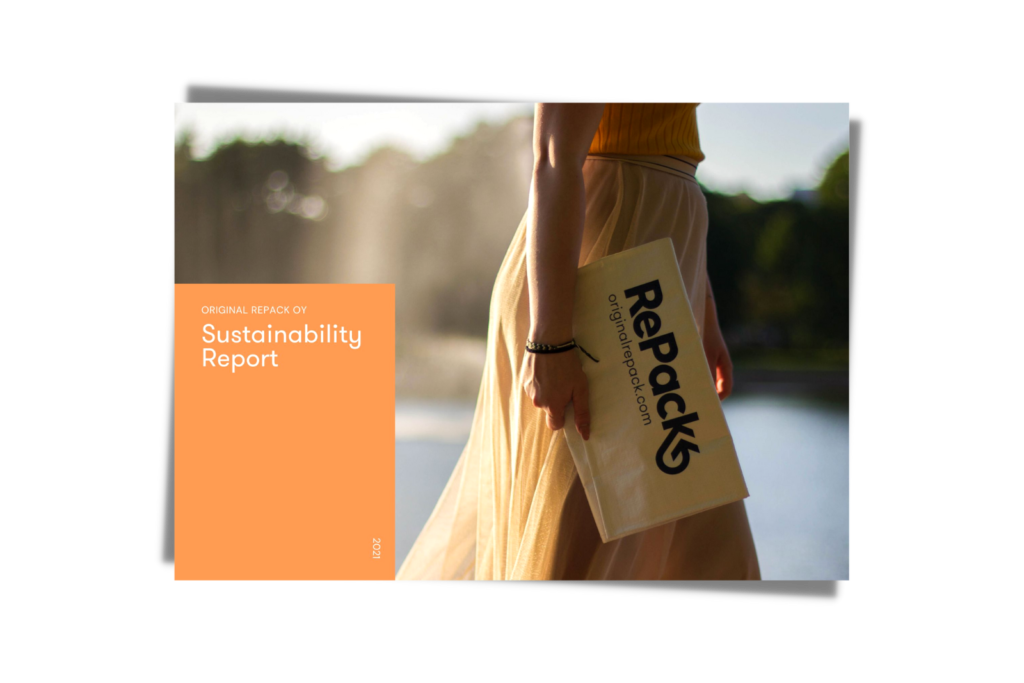Sustainability Reporting Testimonial: Jonne Hellgren, CEO-RePack

In this testimonial interview, we speak with Jonne Hellgren, the CEO of Finnish circular packaging service company, RePack, to talk about some key aspects of, and drivers for publishing their first sustainability report with the help of Askel’s sustainability reporting services and insights into the working process and the experience itself.
Interviewer: Could you tell us a little about RePack?
Jonne Hellgren: RePack is like the application of the bottle return system but for e-commerce deliveries. So we started as a sustainable design agency in 2010-2011 when Finnish post offices saw the rise of e-commerce in the warehouses and the single-use packaging that goes with buying something online and having grown up with the bottle return system we felt that that system is convenient, it’s rewarding and it’s environmentally friendly, reusing bottles and cans, and wanted to apply that to e-commerce. So I have a sustainability background, like an LCA background and we wanted to combine industrial design to sustainability analysis so that we can actually design better products and prove that things are more environmentally friendly with new solutions. And that’s how we invented the whole idea of applying return system to e-commerce deliveries, and now reusable packaging from us is used by over 200 online retailers in Europe and North America. And that’s kind of the background, we wanted to prove that more sustainable solutions can be designed, done, and also done in scale.
Interviewer: Could you tell us a little about sustainability at Repack and how a sustainability report fits in?
Jonne Hellgren: So one of the first things we did when we came up with the idea was to model the carbon footprint and the life cycle analysis on a high level that does reuse make sense in e-commerce, and we quite quickly found out that you can reduce emissions with reuse by around 80%, depends a bit what you compare it to and where it’s used but it was clear that reuse is not just a small improvement, it’s a significant improvement into the existing system and us being kind of a value-driven company, and knowing how difficult changing something is on a systemic level, it would have been crazy to invest all this time if it wasn’t more sustainable. It’s hard enough to introduce new products and if it doesn’t change anything for the better, then what’s the point? So being more sustainable than single use is in the core of the company. RePack is the only product we have and it’s all centered around reuse and circularity. So everything stems from the product being more sustainable than single-use alternatives, and now that we are working with bigger companies, with global multinationals, the requirements from them on how we measure things and report things are increasing, so adding that more formal sustainability report helps us to be more credible partners to the companies that we work with.
Interviewer: What were the main drivers for publishing a sustainability report?
Jonne Hellgren: With a product like RePack, you have quite a lot of data points, the material it’s made of, where it’s returned from, how many times it’s been used, what is the distance it’s traveling, and what is it compared to. What is the impact of a single RePack, and what is the impact on a systemic level, so there are a lot of data points that we didn’t really have a wholistic view, which kind of the reporting process helped us to put all these numbers into one place and kind of create a more coherent story of our sustainability credentials and then to use that to, of course build the sustainability report, but also other shorter stories about benefits of reuse and RePack’s potential in different communication channels like social media and newsletters and so on and the bag itself. Every user that gets a RePack delivery, they also need a convincing story like what is the impact of reuse, what does it matter if I return this, does it matter? What is the impact? Ya, the demand for transparent data and structured reporting is increasing. It’s been talked about for years and years and years that it’s increasing but at least when I was working in sustainability consultancy, most of the reports were written by sustainability experts and read by experts, and nobody else, whereas now more and more like purchasing departments, marketing departments are looking for data on how to prove that the decisions they are making are based on science and structured reporting and a systematic way of doing things but also on how to tell that story in an engaging and easy way, and reports kind of give everyone that structure, the numbers are there and can be easily used in different communication channels.

Interviewer: Was it important for Repack to have a report that was in accordance with the GRI core standard, and if so why?
Jonne Hellgren: The GRI really matters when you are working with multinationals where their procurement and sustainability teams rank you as a supplier and compare you with others. So having that is part of not just saying that we are sustainable and having that in different data points but having the stamp of approval that ya things are done in a standardized way. So, while the company grows and the customers become bigger and more demanding, it is really important to have that.
Interviewer: As a company publishing a sustainability report for the first time did you feel that outsourcing part of the process helped your company save on valuable resources?
Jonne Hellgren: Ya outsourcing the reporting and data gathering was absolutely essential. I don’t think we would have managed even to do the report without Askel’s help, because there are just so so many things to do when you are trying to build up a company. Ya, I think without external help it would have been one of those projects to do on that to-do list for years.
Interviewer: Did you feel that the report in terms of design and content stayed true to the style and identity of the Repack brand?
Jonne Hellgren: When creating a brand like RePack we have quite a distinct tone of voice and how we want to represent things, and that is probably why we won so many design and sustainability relate awards. So building on that sustainability report cannot look like it is not coming from RePack. It’s important that it follows the brand guidelines and looks like something that is easy to approach, flows nicely, is visually appealing, and is easy to read. It needs to be easily approachable in order to have some kind of a wow factor for the reader as well that more thought has been put into this than just typing things in black and white on an A4 and pdf printout.

Interviewer: Do you feel that the sustainability report was able to present data more comprehensively than you had perhaps earlier?
Jonne Hellgren: So big corporations often ask for multiple data points whether they are how things are manufactured, how they are transported, what is the material used, recyclability, what is the LCA, and different kinds of studies, and then responding to these requests with one complete report that follows the GRI, usually helps a lot, both us, in time to deliver that information but also for them that it is in a structured format that they are used to.
Interviewer: Could you talk a little about your experience as a company working with the sustainability agency, Askel?
Jonne Hellgren: Just as when we started RePack, as a young company you won’t be successful unless you listen to your customers and their needs. It’s not about what you want to do, it’s responding to customer demand. So I thought that Askel had a great way of understanding what we need but also we felt that you also understood that we are a small company with limited resources, so everything related to data collection was well prepared in advance, so it was easy to know what kind of data is needed. The communication was professional but still like in a nice manner. And most of all for a company like us you were patient, in that it’s ok that it might take some more time to get the required data than it would if you were working with a larger corporation with a dedicated sustainability team or professional in-house. So I felt like we got a report that makes us look bigger than we are, which is great.
Transcribed and edited by Saumya Tyagi
